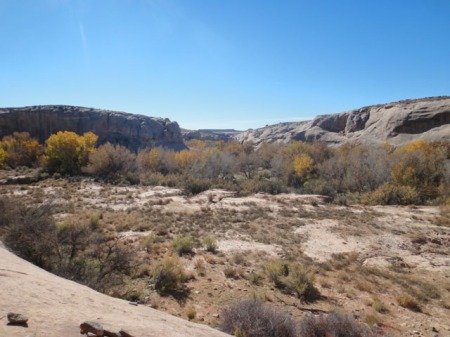When Nicolai and I are in the bush our eyes are always open, constantly searching for signs of the ancient inhabitants, for birds and mammals, and for tracks along our trail. There are tracks to be found everywhere; often they are not human tracks in many of the places we find ourselves, but always tracks of coyote, lizard, beetles, and other desert dwellers. All tracks are interesting, and all tracks tell a story. We often stop to read tracks when we find them- we spend some time looking at them, find out where they came from, where they are headed, and try to deduce what the track maker was doing at the point we found them. It is much like detective work. We look around us collecting all the available information: track size, stride, gait, the path of the track, the details of the immediate vicinity including vegetation, water, and even geology. All of these details added up help us build our tracking picture; that is, the overall disposition of the track maker. They inform us about what happened when this animal passed through this exact location when it did, what the animal was doing, its purpose. Tracks and other sign help the tracker decide whether the animal was hungry, thirsty, frightened, tired, old, young, injured, or healthy.

Looking down canyon from the canyon rim. Nicolai and I easily followed many sets of tracks up this canyon including lots of deer- tracks in the moist, narrow canyon bottom are some of the easiest tracks ever to follow. We weren’t sure if there was a way out, but based on the deer sign we guessed the deer know something we didn’t. At the canyon head we found an old cattle trail leading up to the rim.
But it is not just a matter of looking at the tracks in the sand, or the grass that is pushed aside, or the bit of fur left in a thick section of brush. All of this is important- these are absolute pieces of data which add to our picture. But just as important is what we perceive on the inside, what we feel about the animal that passed by here and left the clues. When we are following sign, we are not only collecting clues, but we are doing our best to mentally become the animal we are following. Based on the clues we collect and the tracking picture we build, we put ourselves in the animal’s skin, we make our mind its mind. This is the way, we are told, that the best trackers work. They become their quarry, the develop a relationship with it. And if they are hunting it for food, and they are successful, in the end they mourn for the animal they have tracked and hunted, because the animal became part of them.
These very basic tracking concepts- especially the part about thinking like and becoming the animal- are something that Nicolai and I talk about, something that we have been practicing- or at least doing our best to practice, for years now. I think that many of the books that we have read, and that we have put on our Tracking Bibliography on the Desert Explorer website, discuss these concepts. Some go into it more than others. One book that really dwells on the point is Louis Liebenberg’s The Art of Tracking and the Origins of Science. I mentioned this book in a recent post, and noted that it is available for FREE as a PDF download from the author’s website. I have downloaded and had my own copy printed for our library. Liebenberg’s approach to tracking is unlike any other author I have yet read. He begins at the beginning- he starts way back with our hominid ancestors and works forward to modern Homo sapiens, speculating along the way about how tracking came into being and how it developed, and complemented the overall development, of our species. I highly recommend the book to anyone who really wants to get a feel for tracking in the most primal sense.

Another section of canyon bottom. We found deer, coyote, lizard, chipmunk, turkey, human, and of course cow tracks here.
Another book that Nicolai and I have just finished reading is called The Harmless People. It is about the bushmen of the Kalahari desert, written by Elizabeth Marshall Thomas. This book does not cover tracking specifically as much as The Old Way, another book by the same author. Both books are studies of the bushmen lifestyle and the author’s experience there with her family in the 1950’s. This was before the profound changes that occurred which have catapulted the bushmen into the 21st century, causing them to abandon many of the skills that kept them alive for hundreds, if not thousands of years. Both books have a revised afterword that was written in the late 1980’s which addresses the changes. Both books are written more for the laymen rather than the archaeologist, but will be enjoyable and important to both, if they have an interest in the hunter gatherer societies and how they lived.
Read more about our desert adventures at the Desert Explorer website, and more about us specifically on our biographies page.



 Posted by desertexplorer
Posted by desertexplorer